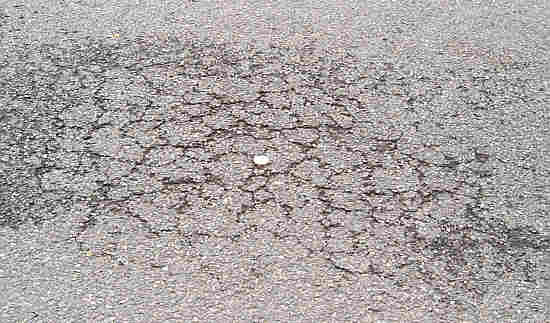
It was only a matter of time as the city found out the bad news back in February, that it would have to spend a huge amount of money on roads if it wished to avoid a prognosis of failed roads within thirty years with a price tag of 444 million dollars. However, the abstract is still the abstract, and until now we have not seen the specifics of what roads will cost us now.
Staff recommends four components to the roads plan. First, that the council approve the funding and budget strategy for pavement maintenance, in concept, for the multi-year period. Second, staff would be directed to proceed with the first year, planning the project, obtaining a design consultant and a public outreach consultant.
Third, by the fall there would be an update on the long-term pavement maintenance budgeting plan with contracts for Design and Public Outreach Consultants for next fiscal year’s Pavement Maintenance project.
The fourth part is the bottom line, it would be to approve the pavement management scenario, with Front End Loading which amounts to $15 million in year 1 and $10 million in year two.
The current budget only calls for $2.3 million to put toward street maintenance, and $1 million of that is the money budgeted from last year that was carried over from last year.
On February 5, the council received the Pavement Management Report prepared for the city by Nichols Consulting Engineers. Council needs to bridge “the funding gap between the current baseline budget for pavement maintenance and the budget it would take to halt the steady deterioration of our average pavement conditions and reach a sustainable level acceptable to the community.”
The report found that if the city council did not immediately infuse tens of millions into road maintenance and spend $150 million, they would be facing a $444 million deferred maintenance hole.
We knew at the time it was a very difficult vote to basically move $1 million into the roads and $200,000 into the bike paths,” Mayor Pro Tem Dan Wolk said at the time. “That was a difficult vote and we knew at the time… that that really wasn’t going to solve the problem by any means.”
“But seeing this report shows you how really a drop in the bucket it really is,” he said. “It’s very daunting and sobering to realize and think about where we’re going to find this $150 million.”
Writes city staff in the staff report for today’s meeting, “The fiscal impact of transportation infrastructure operations and maintenance activities is significant and is a major component to be considered in the City’s overall budget. The long-term sustainability of a safe and effective transportation system involves the coordination of many different City services.”
By frontloading the contract, the city hopes that after the initial $25 million in expenditures, they can decrease the yearly hit to $3 million per year over the next 20 years through the year 2032.
Writes staff, “These numbers could change depending on what Scenario is finally chosen but the front loading profile is still recommended. As has been shown at the previous Council Meetings, the City’s streets and bikepaths are in such a condition that they require remediation as soon as possible, and front loading the budget is the best way to address that issue.”
The strategy that staff recommends would ask the city to “heavily fund pavement in the second and third years (14/15 and 15/16) but future year funding would be based on meeting average PCI goals for streets based on the following: arterials to be brought to an average PCI of 68, Collectors (and priority locals) to an average of 65, and local streets to an average of 60. This scenario was re-run with front-end loading of the first two years with $15 million in the first year and $10 million in the second year.”
At the April 9, 2013 meeting the council came up with the Guiding Principles of Pavement Management.
One of the critical goals is to lower expectations of the Pavement Condition Index from the current standard of 70 to the low 60s, depending on the road type.
Writes staff, “Set a general goal for the average PCI for pavement from 70 to the low 60’s. This recognizes that an average PCI value does not fully address the best interests of the community and should not be the overriding factor driving maintenance decisions.”
Under these goals, the arterials would be highest priority and the goal would be a PCI of 68, collectors would be 65 along with priorities, and other local streets would have a goal of a 60 PCI.
The bottom line is that the city is recognizing that it can no longer keep all roads at the same level and, therefore, in order to prioritize factors like safety, the city is relaxing standards on less traveled roadways.
The city would still prioritize “the higher volume streets and/or streets serving key areas such as: commercial zones, parks, schools and public facilities. These streets should also include all roads that serve bus routes, have bike lanes, or serve as key bicycle corridors.”
Furthermore, the city recognizes that allowing streets to degrade is more costly that keeping up with the maintenance and thus will “employ a maintenance strategy that prioritizes keeping as many of the streets currently in good condition from deteriorating to a poor condition and only invest significant funds to address existing streets in poor shape when overall public safety cannot longer be addressed with minor patch paving and other low cost treatments.”
From 2000-01 until last fiscal year, a span of 12 fiscal years, the city spent just $10.6 million on roads, according to data the Vanguard acquired from the city. That comes to about $890,000 a year.
Over that period of time, the city only used $577,862 from its general fund, and $400,000 of that came in 2004-05, the year after the city received no money from the state or federal government.
This issue did not sneak up on council. In 2009, Interim Public Works Director Bob Clarke was warning the city of the impending crisis.
At that time, it was funded at the $810,000 baseline level. However, that funding level was insufficient and it was reported that current funding would lead to the deterioration of street conditions.
In 2009, the funding to address the backlog would require an increase to $2.8 million per year and full funding, to maintain the desired pavement index, deemed to be in excess of $3 million per year.
What did the council do about this? Nothing, and Bob Clarke had virtually the same report in 2010 and even 2011.
There are, of course, two remaining questions. The first is where the city intends to find $25 million in the next two years and the second is how the city intends to go from current levels of funding up to $3 million on a yearly basis.
—David M. Greenwald reporting








Too bad our roads are not represented by a union.
Frankly
It warms my heart to hear you acknowledge the power of unity of action in achieving important goals ; )
Public outreach consultant? Is that a $10 contract for someone to send an e-blast stating the roads are in horrible condition and some extraordinary action is required to fix them? And why is implementation being delayed a year for even more road surface to disintegrate? Is it a timing issue driven by when various pots of money are available to be borrowed from?
-Michael Bisch
I suspect the reason is that they won’t have the money in time to let the contracts next spring and they may not have the work done to determine priorities.
Have a bit more info. The city has some current projects that will be funded with previous funding. The city is going to use the remainder of the year to come up with the strategy for 2014-15.
The city is going to be tearing up perhaps half the town in the next few summer months, and feel that they need public information to get out there about teh work. not only will there be paving, but trenching because of the surface water project – so a ton of work going on.